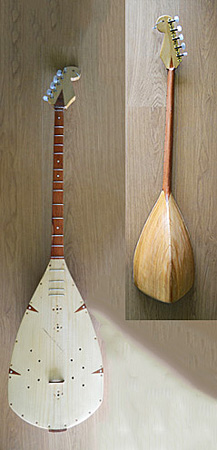
Owner: HWMC
Catalog#: 2CL-CHLT-097
Miscellaneous Lutes
Bosnia & Herzegovina 'Šargija'
Bosnia & Herzegovina
Custom Hand-made
Ash, maple, cherry, plum woods, metal strings
2018 A.D
Length: 45.5 in, Width: 10 in, Depth: 7.5 in
Strings – Lutes – Miscellaneous Lutes
The Bosnian šargija anglicized as ‘shargia,’ originated in Bosnia and Herzegovina around the 1500s. It is a fretted long-neck lute used in the folk music to accompany singing and dancing of various Balkan countries including Bosnia and Herzegovina, Serbia, Croatia, Albania, North Macedonia, and Kosovo. In Herzegovina, it is still known as a tambura. The šargija is part of a larger family of instruments that includes the Balkan tambura and the bağlama (or tambura saz), tamburica, and the tambouras.
This instrument has a teardrop shaped body, almost triangular and coming to a rounded peak in the back. The body, neck, head and face are carved from three distinct stains, with the head and face the lightest followed by the body and then the neck. The face is also decorated with some small triangular sections of the dark wood, and there are burned cross and foliage decorations across the face creating trim. There are five metal strings with mechanized tuning pegs and mother of pearl grips. 17 metal frets are attached to the neck and top of the body. Four mother of pearl circles are inlaid on the neck, and another four on the face near the darker stained triangle inlays. There is a small carved wooden bridge. Unique to the Bosnian šargija are the glasnice (sonorous holes), which are drilled in the face board. They are considered to provide better spreading of sound vibrations from inside the kutla (resonator body). The number of glasnice vary from one instrument to another. Some šargija have more than one neck extending from the resonator body. These instruments are strummed and plucked with the fingers.
Reference: https://en.wikipedia.org/wiki/%C5%AOargija
